National Treasures - Iconic American Flags
Click on the image below to enlarge it.
American & International Iconic Treasures
Click on each image for more detail
Apollo 14 Extra Vehicular Activity United States Flag
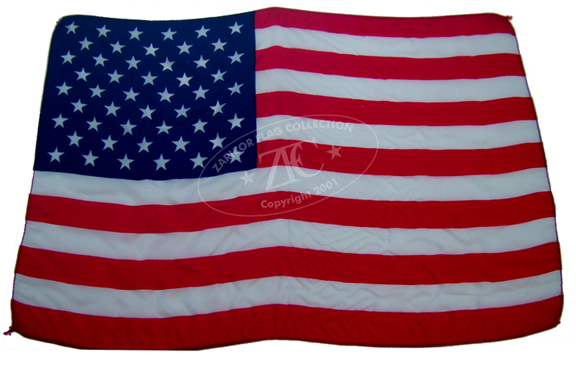
ZFC2521—U.S. 12" x 18", 50 star, Apollo 14 rayon flag displayed during Apollo 14 Extra Vehicular Activity (EVA) on Moon’s surface and returned to Earth by Astronaut Alan Shepard. This is one of only four known American EVA flags taken to the Moon, two from Apollo 11, and two in the Lunar Module Antares. Flag bears an imprint from the tire of the Apollo 14 Mobile Equipment Transporter, 1971. In documenting the flag, Zaricor Flag Collection (ZFC) curator in examining the documents from the previous owner of the flag, the late Thurman (Jack) Naylor (renowned collector of photographica and ephemera material) found the following text: "This flag, the largest [sic] from the moon, was taken there by astronaut Alan Shepard on Apollo 14, January (launched) 1971. The marks on the flag are 'post marks from the moon' after the flag was placed on the moon's surface and was run over by the left front tire of their ‘moon rover.'" There is no author attribution that explains the undulations. The author of this statement is believed to be either Bradford Washburn (friend of Alan Shepard, Director of the Museum of Science, Boston, MA, the original owner of the flag), or the second owner, Thurman (Jack) Naylor. See documents in Paperwork category in the Main Description ZFC2521.
General George A. Custer's Battle Guidons of the Civil War
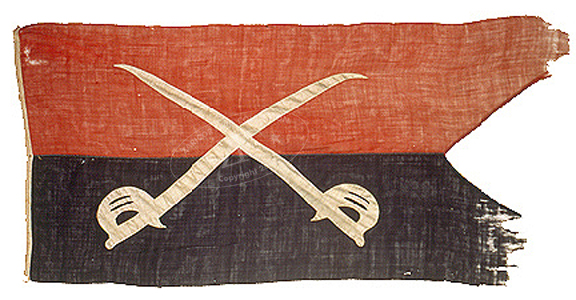
ZFC0489 - General George A. Custer's Third Personal Civil War Cavalry Guidon -
This wool flag, handmade by the General’s wife, Elisabeth “Libby†Custer, was only flown when General Custer was on the field. This was one of Custer's more famous flags, as it served him from September 1864 to February, while he commanded the 3rd Cavalry Division. After being replaced by the silk, 4th personal, it was sent to his home in Monroe, Michigan. After his death at the Battle of the Little Big Horn in 1876, it was given by Libby to his brother, Nevin, from whom it descended, in the family until it was sold at auction 130 years later.
ZFC0490 - General George A. Custer's Headquarters Command designating Flag, 3rd Div. Cavalry Corp., 1864-1865. General George Custer commanded the 3rd Cavalry Division from May 1864 thru the end of the Civil War 1865. This flag served Custer alongside his personal guidons (see ZFC0489) until the end of the Civil War. A photo of this flag along with Custer's Personal Guidon can be viewed in ZFC1492 with George and Libby Custer and his staff in front of his headquarters outside Winchester, VA. The flag shows heavy battle damage and souvenir taking by Custer's officers.
Flags from the Assassination of President John F. Kennedy
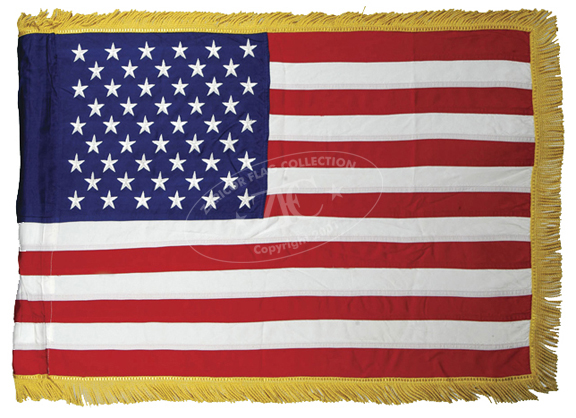
ZFC2500 - 50 Star U.S. Flag, President John F. Kennedy Limousine, Assassination in Dallas 11/22/1963. The last half of the 20th century witnessed continuing changes in the visual media which have dramatically altered our perception of history. Signal historic events have been captured by amateur and professional photographers, whose images were transformed into icons of the events depicted. The assassination of President John F. Kennedy on November 22, 1963, stands paramount as the numbing event of the 1960s. The image of the presidential limousine speeding away with its pair of flags whipping wildly in the wind was seared into the nation’s collective memory. This is the United States flag from that automobile on that fateful day.
ZFC2501 – 50 Star U.S. Presidential Flag, President John F. Kennedy Limousine, Assassination in Dallas 11/22/1963.The first president to travel with small versions of that flag and the flag of the United States mounted on an automobile was Woodrow Wilson in 1919. In 1945 the presidential flag was altered so as to show the stylized coat of arms of the United States as for presidential use, surrounded by a circle of white stars equal to those on the U.S. flag. This flag was authorized for production only six days after the admission of Hawaii as the 50th stars on August 21, 1959. This historic presidential automobile flag is one of the earliest examples of a documented 50-star presidential flag produced by the government.
USS Constitution, 28 Star No. 1 Ensign
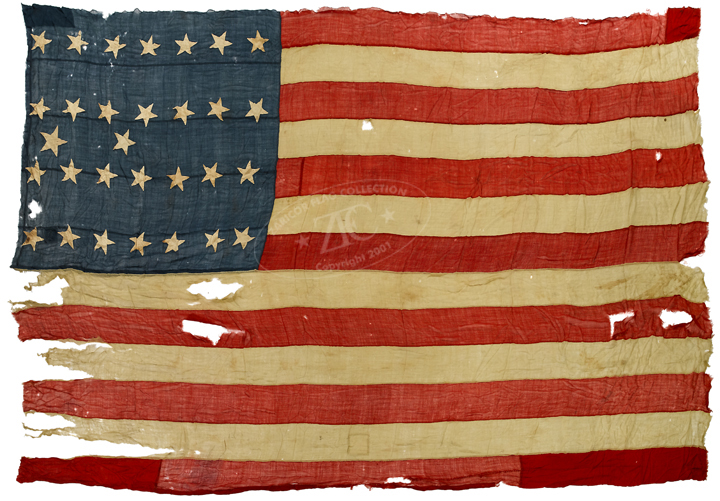
ZFC2588 - USS Constitution No. 1 Ensign - 1845 to 1850. This 28-star ensign, made to commemorate the admission of Texas is from the most famous ship in the United States Navy, the USS Constitution. These U.S. ensigns with these particular star counts were official between 1846 and 1851.
War of 1812 Capture Flag, American Privateer Blockade
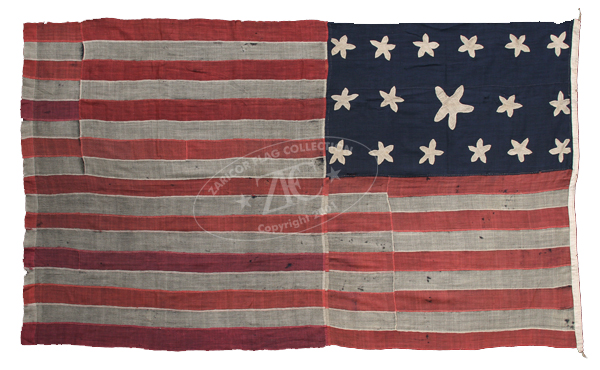
ZFC2575 - United States, 17 Star / 17 Stripe ensign – This unique ensign from the privateer “Blockade†commanded by Captain Elijah Mix during the War of 1812 was captured on 31 October 1812, by Captain James Clephan, commanding the HMS Charybdis. This flag it is significant for both its rarity and symbolic importance. There are no other 17 Star – 17 stripe U.S. flags. This flag was preserved as a trophy of war by Captain Clephan, and descended in his family until acquired. The flag, datable to the 1803 to 1812 period, bears all of the hallmarks of early 18th century vernacular chandlery or ship-board manufacture; hand stitching, pieced bunting, tarred rope, and single-appliqué stars. The flags most striking feature is the stars, which have a rounded, flower like appearance. The center star of the center row is larger, a design motif with origins in the Revolutionary War.
First U.S. Flag Captured in the Civil War, and Recaptured
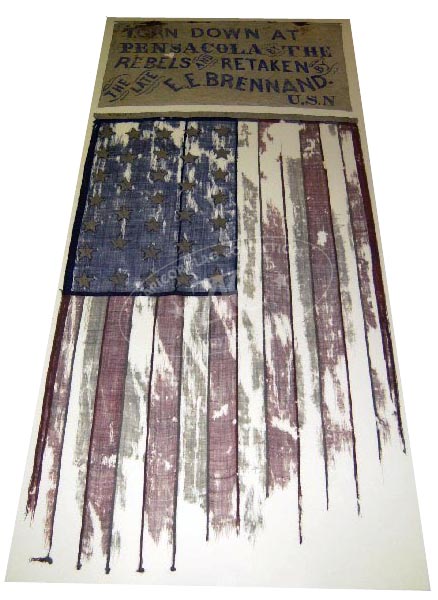
ZFC2510 - First U.S. Flag Captured in American Civil War flag – This 33 star US storm ensign was captured by Southern Secessionists near Pensacola, Florida in January of 1861. The flag was taken from the either the Warrington Navy Yard or Fort San Carlos de Barrancas, the army post protecting the yard and Pensacola Harbor. According to the accompanying provenance, the flag was “desecrated†by its captors by contemptuously dragging it in the dust. A US Navy Lieutenant, Edward E. Brennard, ashore under a flag-of-truce, witnessed the desecration, but could not abide it, recaptured the flag and ended the disgrace. The flag is thus the first flag captured and then recaptured during the American Civil War. Lt. Brennard journeyed to his home in Pittsburgh, Pennsylvania and left the flag with his sister, Mrs. John Erwin. Lt. Brennard was killed in 1863, but his sister Mrs. John Erwin, allowed the flag to be memorialized to him and then displayed in celebration of the 2nd election of President Abraham Lincoln in November of 1864.
The CSS Alabama's Last Battle Flag
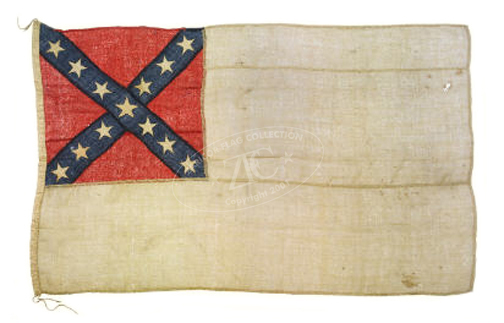
ZFC2590 - Confederate States – 2nd National. CSS Alabama. This is the ensign of the famous commerce raider, CSS Alabama, presented to the officer’s English host after the 17 of June 1864 Battle of Cherbourg when the Alabama sank after her poor gunpowder proved fatal.
French National Guard Color, Paris Commune, 1871
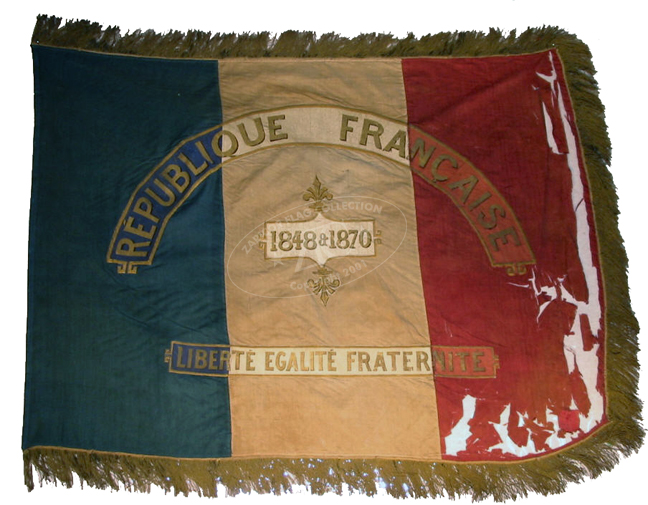
ZFC0417 - France - 15th Battalion National Guard Color, 1870 - This French Battalion Color was formerly part of the collection of the M.H. de Young Museum. Its distinctive inscriptions identify this flag. Following the defeat of the French Army in the 1870 war with Prussia and the creation of the radical Commune in Paris, the regular Army was replaced by a National Guard (the term 'National Guard', as used in France was not the equivalent of the term as used in the US, which would have been properly labeled a 'militia'). This 15th Battalion color features the dates 1848 and 1870, honoring the victories in those years by republican forces. This flag is extremely rare as the National Guard existed for only a few years.
Only Stand of Colors of the Headquarters of the Army of the United States
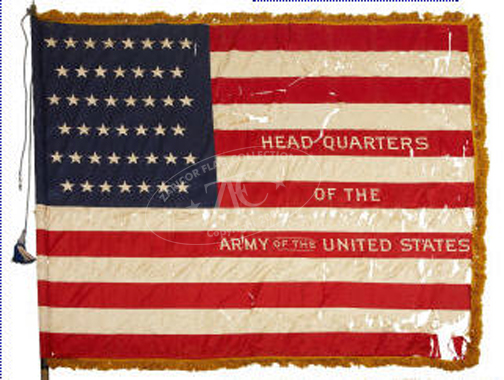
ZFC2583 - US National Colors from General John Schofield, Commanding General, US Army, 1888 to 1895.This 45 star, fringed, silk national color is the only known US flag identified to the Headquarters of the Army of the United States. It was used by the Commanding General of the United States Army, Lt. General John Schofield, who retained it when he left office on September 29th, 1895. The flag was part of the stand of colors, a national color and a headquarters color, with accouterments, which represented the United States Army as a single entity. Due to the large size and intricate embroidery on the national color it is clear that this was used in the office of the Headquarters of the United States Army located in the State, War, and Navy Building next to the White House in Washington D.C.; the building where the ceremonial headquarters of the Commanding General of the Army of the United States were located.
ZFC2584 - U.S. Army Headquarters Color from General John Schofield, Commanding General, US Army, 1888 to 1895. This flag was part of a stand of colors: a national color (ZFC2583) and a headquarters color, with accouterments, which represented the United States Army as a single entity. It was authorized on December 15th, 1880, some seventy-six years prior to the creation of the current Army Flag which was not issued until June 12th, 1956 under an Executive Order by President Dwight D. Eisenhower. This flag is described in the Consolidated Correspondence File of the Quartermaster General, 1794-1914 in the National Archives, and was used by General Schoefield in his ceremonial office located in what is now called the Eisenhower Executive Office Building, located next to the White House in Washington D.C.
Pegasus Guidon of the 6th Airborne Division – United Kingdom, WWII
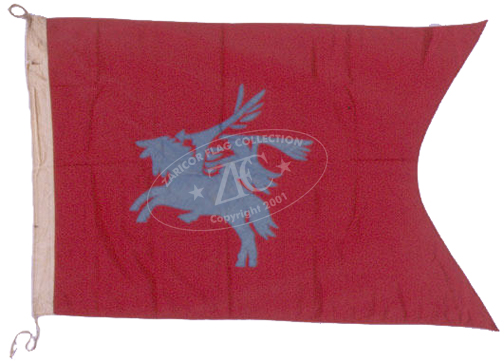
ZFC1271 - UK, 6th Airborne Division Headquarters Guidon, WWII – This British Airborne Divisional HQ Command Pennant draws its symbolism from Greek mythology. It depicts the winged horse Pegasus carrying the slayer of monsters Bellerophon, the first "airborne warrior." It came directly from the Estate of United States Army General Matthew B. Ridgway. Ridgway acquired the guidon as a token of appreciation, and a memento of command from elements of the British 6th Airborne Division after the crossing of the Rhine and the advance into Germany in the spring of 1945, when he visited the British Airborne's headquarters in Wismar, Germany, on the Baltic coast, for a wars-end Thanksgiving Service.
General Philip H. Sheridan's Personal Battle and Headquarters Flags of the Civil War
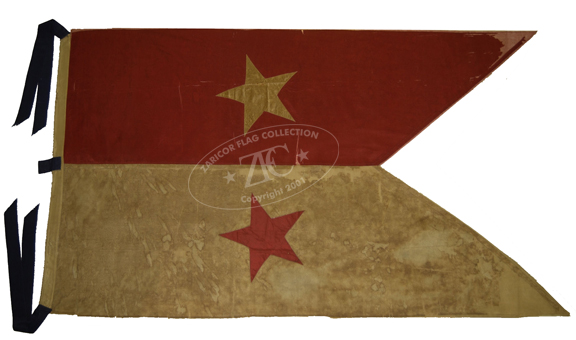
ZFC2576— Major General Phillip Sheridan’s Personal Civil War Battle Flag, 1864 to 1865 - This is the personal Civil War battle flag of General Philip Sheridan (1831-1888). It was used by Union's greatest cavalry commander through his most illustrious campaigns in 1864 and 1865. General Sheridan was arguably the ablest Union cavalry commander during the American Civil War. He was a career US Army officer, noted for both his meteoric rise to Major General, and his close friendship and association with General Ulysses S. Grant. He used this red over white guidon countercharged with two five pointed stars after his appointment to command the Union Army of the Shenandoah in 1864 and 1864, carrying this flag at his famous charge at the Battle of Five Forks, 1 April 1865.
ZFC2577 - General Phillip H. Sheridan Personal 35 Star U.S. National Colors, 1864 - This 35 star silk United States national standard (1863-1865) was used during the American Civil War by Major General Philip Sheridan as both the Cavalry Corps Commander of the Army of the Potomac and the Commanding General of the Army of the Shenandoah. Surviving army headquarters staff flags are extremely rare and Union cavalry commanders' national flags are unknown. This example is thought to be unique. Made of silk this headquarters staff flag was similar in purpose to U.S. flags displayed by both Generals Grant and Sherman at their headquarters except that, in keeping with Sheridan's mostly mounted command, it, like the cavalry's standards, was smaller than army infantry counterparts.
1785 Patriotic Textile, The Apotheosis of Benjamin Franklin with Early American Flags
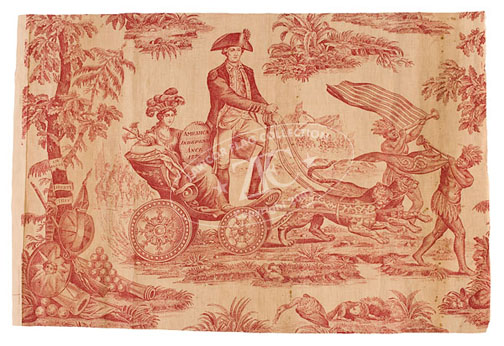
ZFC3259 - English Patriotic Textile "Apotheosis of Franklin" - This textile is a memorial vignette to Benjamin Franklin from after the Revolution and is printed on fine fabric with a cotton warp and linen fill. It is printed in a rich, reddish-brown, showing George Washington in his military Generals' uniform along with Benjamin Franklin in his famous Beaver cap. Entitled: “The Apotheosis of Franklinâ€, this textile was conceived in honor of Benjamin Franklin upon his death in 1790. Franklin holds one end of a banner, which reads, "Where Liberty Dwells, There is My Country." This textile is cherished as a classic of early Americana, and is well-documented, including being listed on page 51 of the important reference work, published by the Smithsonian, “Threads of History."
The South Tower Flag of the World Trade Center
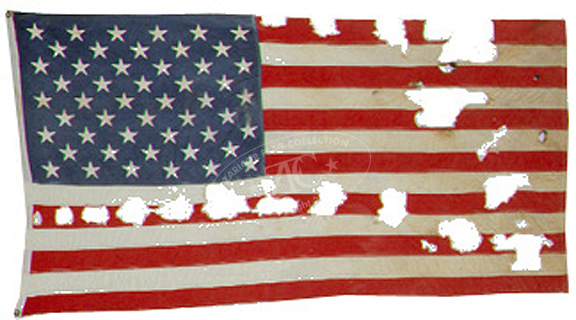
ZFC3911 - The South Tower Flag, World Trade Center, NY 9/11/01. This 50 Star U.S. Flag, was recovered by a volunteer fireman working with the New York Fire Department during the recovery phase of the clean-up at the World Trade Center (WTC). While sifting through the rubble, the volunteer fireman discovered what he thought were fragments of clothing from a victim of the September 11th terrorist attack. As he dug further, he realized he had found the smoldering remains of a United States flag. From the amount of office equipment found in the same area, it was speculated that the flag had decorated one of the offices of the WTC.
Last Surviving Union Jack from the Battle of Trafalgar - 1805
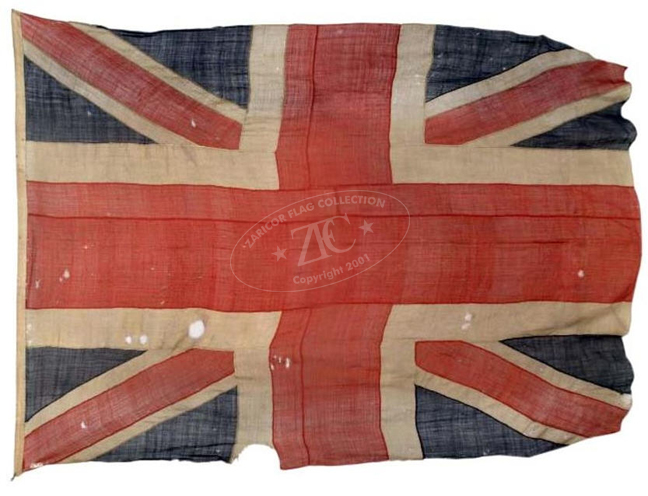
ZFC3400 – Union Jack - This exceptionally rare Union Jack was worn by HMS Spartiate at the Battle of Trafalgar. This is a finely preserved crew-made, flag that was documented by the U.K.’s National Maritime Museum in Greenwich, England in 1947, as the last documented surviving flag from the Battle of Trafalgar, and was acquired directly from the family. It was displayed from the foremast of HMS Spartiate at the battle of Trafalgar on the 21 October 1805. It is comprised of thirty-one hand-stitched bunting panels with a canvas and rope hoist. It was presented to Lieutenant James Clephan R.N. as a mark of esteem for gallantry by the crew. Lt. Clephan had led the boarding party to the Spanish ship Neptuno; after Trafalgar Clephan was made the Spartite’s First Lieutenant.